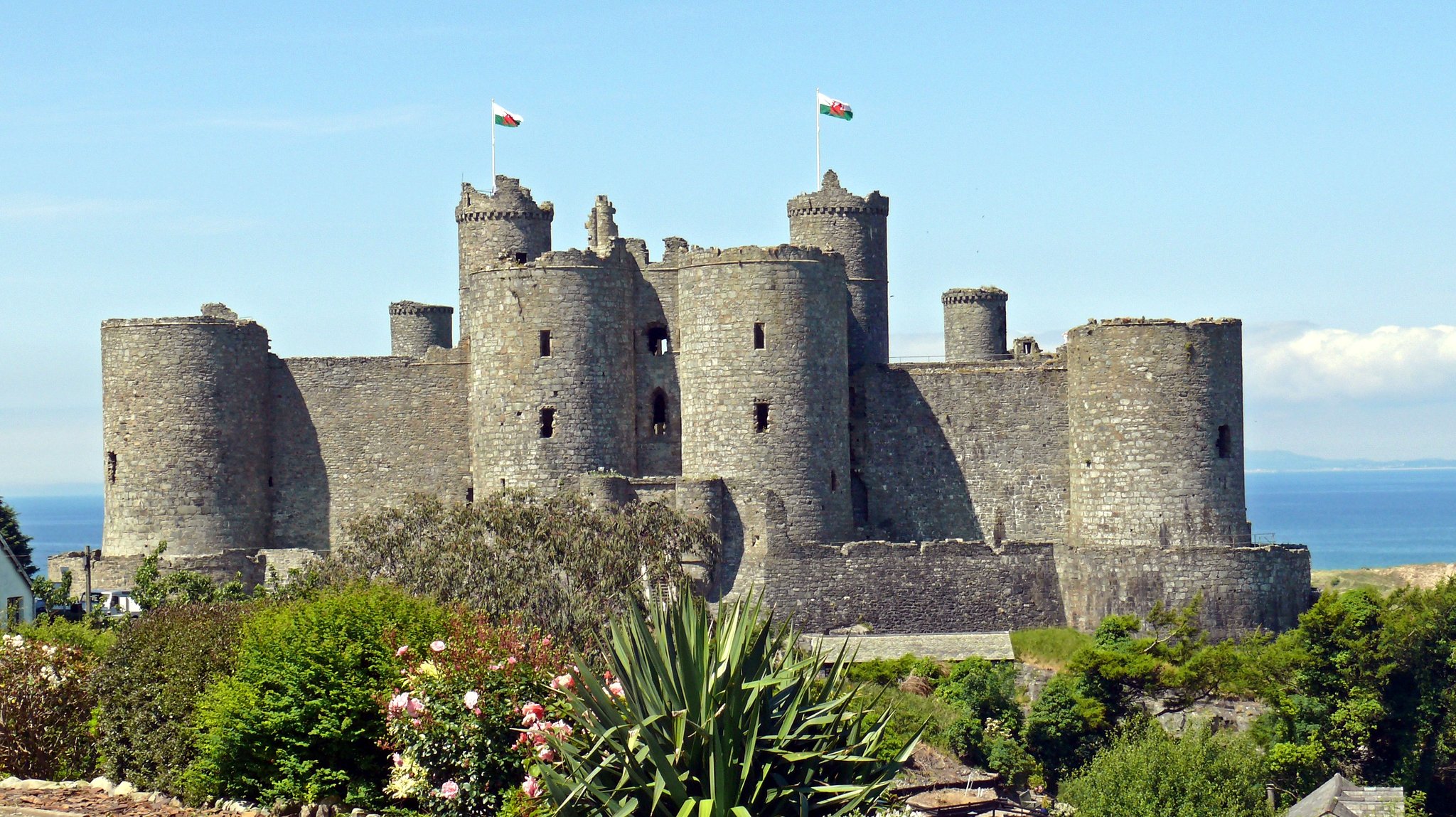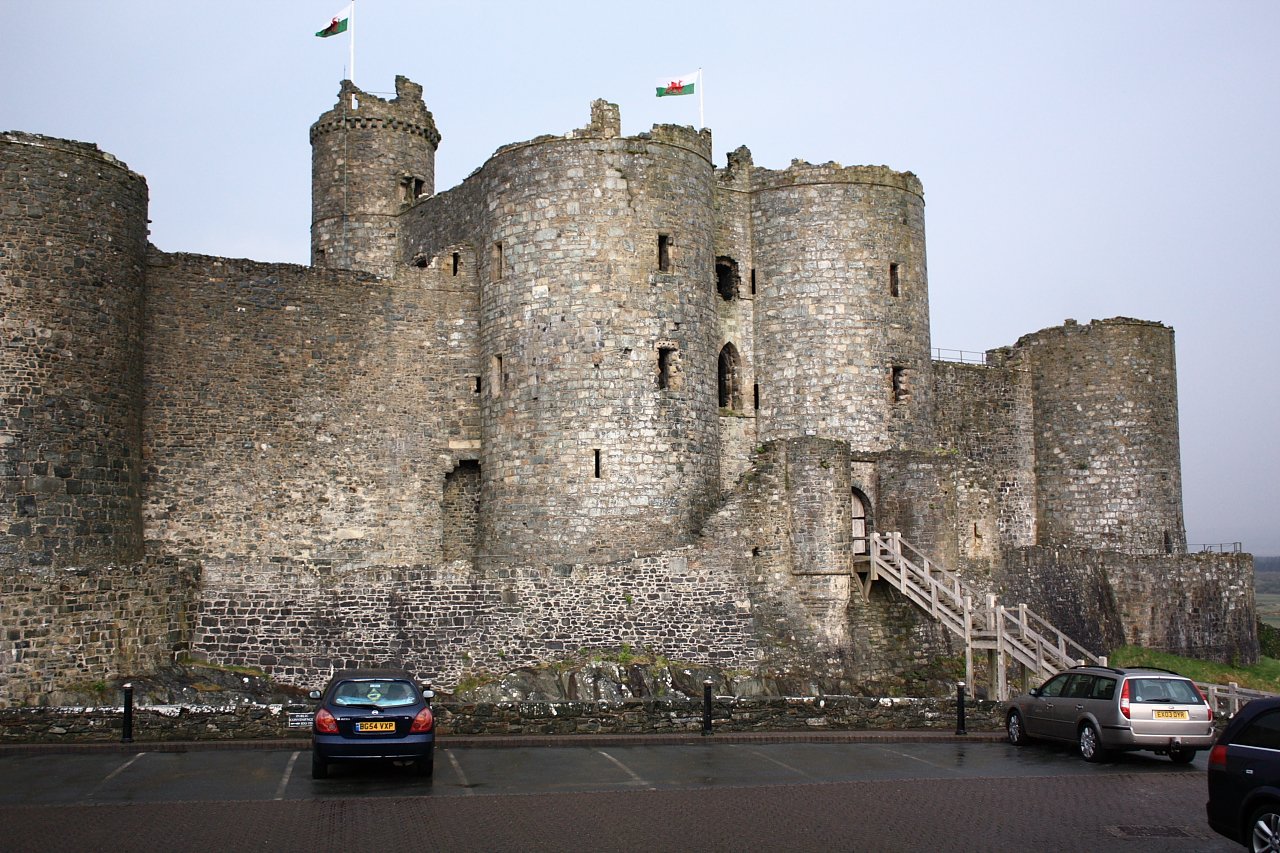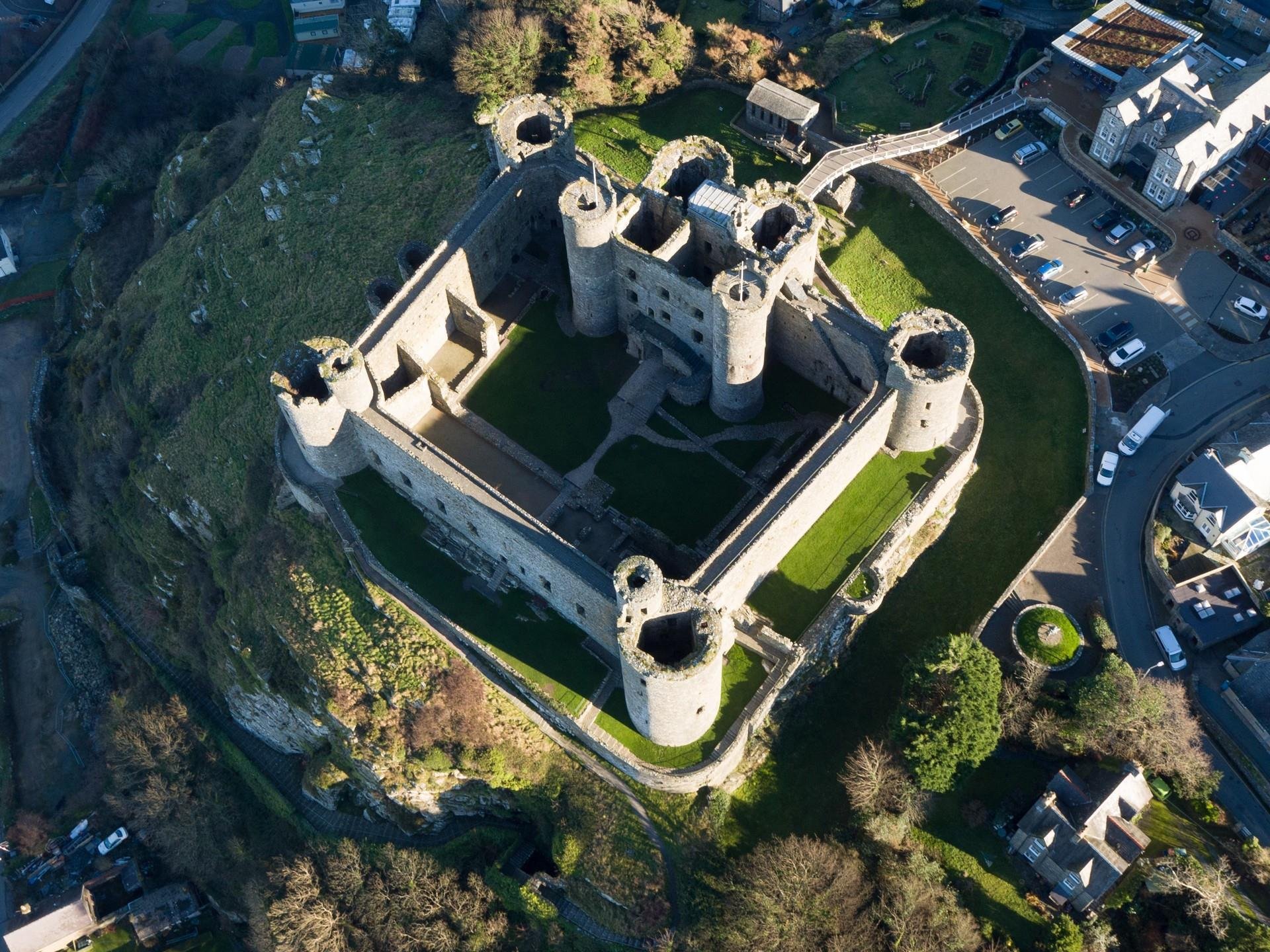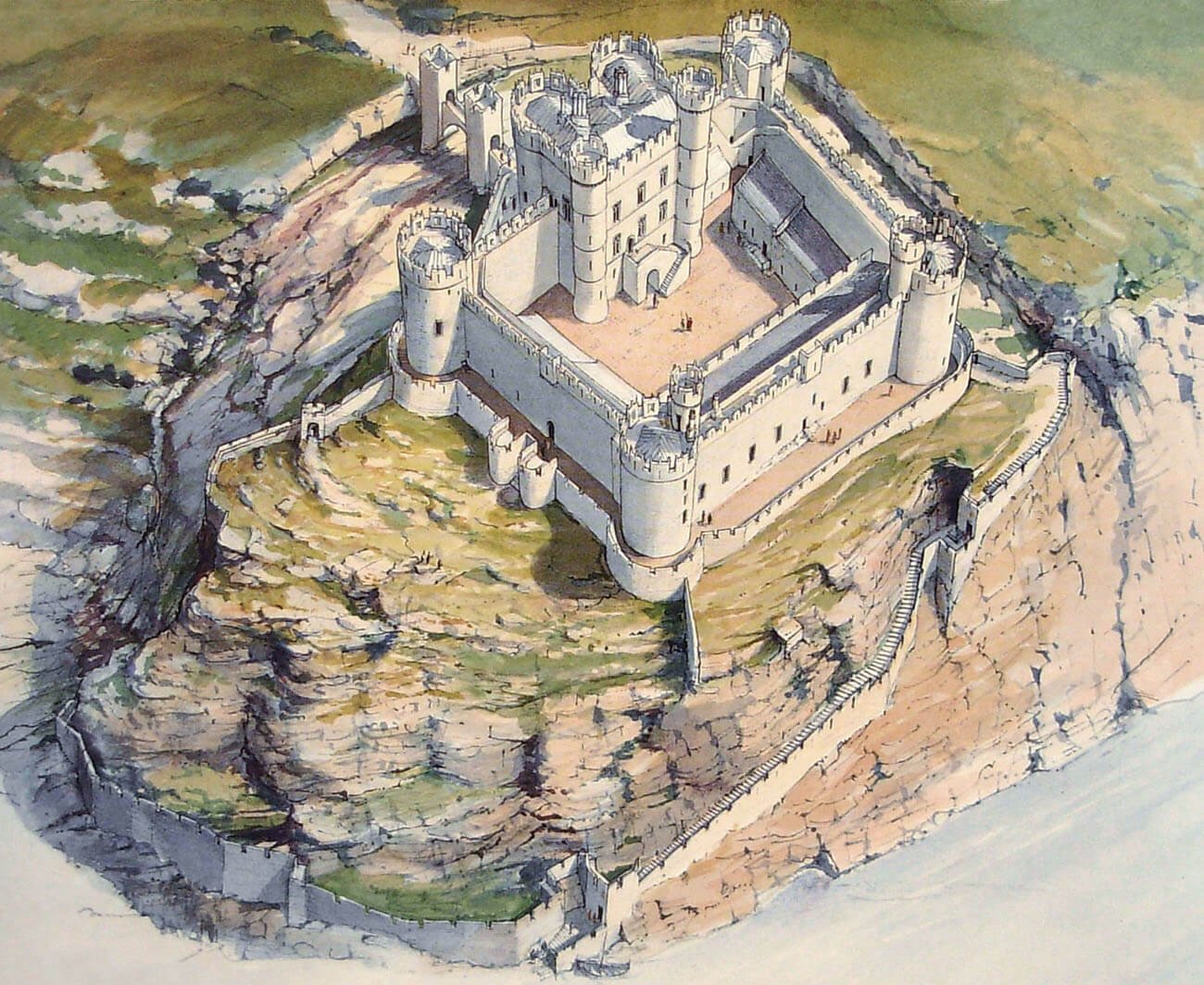Harlech Castle | Visit Amazing Welsh Castles
Harlech Castle stands on a rocky hill overlooking the Irish Sea in Gwynedd, North Wales. Built during the reign of King Edward I in the late 13th century (about 1283–1289), it formed part of the English monarch’s chain of castles known as the Iron Ring.
The castle’s elevated position provided military advantage and clear sea access, making it a key stronghold in several conflicts, including the Welsh Wars and the Wars of the Roses. Today, it is managed by Cadw and recognised as a UNESCO World Heritage Site for its military architecture.
Quick Facts
Location: Harlech, Gwynedd, Wales
Type: Concentric stone fortress
Built by: King Edward I of England
Construction Period: 1283–1290
Historical Use: Military stronghold, administrative centre
Notable Feature: Direct sea access via a fortified stairway known as the "Way from the Sea"
World Heritage Status: Part of the UNESCO "Castles and Town Walls of King Edward in Gwynedd"
Dog Policy: Dogs allowed on leads (verified by Cadw)
Managed by: Cadw, the Welsh Government’s historic environment service
Brief History
The castle was commissioned by King Edward I following the conquest of Wales in 1282. Construction began in 1283 and largely finished by 1289, at a cost of around £8,190, about 10 % of his total Welsh castle expenditure. It was designed by Master James of Saint George, a prominent Savoyard architect, who oversaw a workforce of stonemasons, quarriers, carpenters, blacksmiths, and labourers.
The castle first faced siege in 1294–95 during Madog ap Llywelyn’s rebellion. The unique “Way from the Sea”, a fortified stairway of 108 steps, allowed sea-borne supplies to reach the garrison, enabling Harlech to resist successfully.
In 1404, Owain Glyndŵr captured the castle in his revolt against English rule. He used it as a centre for governance and possibly held his parliament there. The castle remained in his hands until 1409, when forces led by Henry V, then Prince of Wales, retook it by siege and heavy artillery.
During the Wars of the Roses, Harlech withstood a seven-year siege (1461–68) under Lancastrian defence. Note the 1461–68 siege was mostly a lengthy blockade with intermittent attack. Its fall in 1468 to Yorkist forces inspired the ballad "Men of Harlech".
In the English Civil War, Harlech was the last Royalist stronghold to hold out, finally surrendering in 1647 to Parliamentarian troops.
Today, it stands as a ruin managed by Cadw and is recognised as a UNESCO World Heritage Site, one of the finest examples of Edwardian military architecture.
Features and Layout
The castle displays a classic concentric design, with an inner ward enclosed by a taller curtain wall and an outer ward providing layered defence.
Main Gatehouse
A substantial double-towered gatehouse dominates the front.
Equipped with multiple murder-holes and a portcullis—designed to repel attackers entering the courtyard.
Curtain Walls and Towers
Four large circular towers protect the inner ward’s corners.
Outer walls include flanking towers enabling defenders to fire along the curtain wall’s face.
“Way from the Sea”
A fortified flight of 108 steps descends the cliff to a lower water gate.
This allowed supply ships to access the castle directly during sieges Gatehouse Gazetteer+11Cadw+11Wikipedia+11.
Barbican and Moat
A rock-cut ditch defends the eastern approach.
An outer barbican added extra defence on the landward side.
Inner Ward Layout
Contains the remains of the great hall, chapel, kitchens, and living quarters.
High-status accommodation existed above the gatehouse, likely for the constable and distinguished visitors.
Did You Know?
The castle’s concentric layout was inspired by Crusader fortresses in the Holy Land—Master James of Saint George applied this advanced design in Harlech.
Images





Legends and Stories
Branwen and the Mabinogi
Local folklore connects Harlech with the legend of Branwen, daughter of Llŷr, from the Second Branch of the Mabinogi. In the tale, seven survivors lingered for seven years at Harlech with the talking severed head of Brân the Blessed, her brother, before moving on—an eerie mythical association rather than historical fact.
“Men of Harlech”
The famous Welsh military march, “Men of Harlech” (Rhyfelgyrch Gwŷr Harlech), commemorates the seven-year siege of 1461–68 during the Wars of the Roses. It honours the determined Lancastrian garrison led by Dafydd ap Ieuan.
The song portrays Welsh resistance and has become a symbol of national pride.
While sometimes linked to the earlier 1408 siege by Owain Glyndŵr, most sources date it to the longer mid-15th‑century siege.
Modern Storytelling Events
Cadw hosts “The Time of Legends” during summer. Visitors can hear tales of giants, dragons, Tylwyth Teg (faeries), and medieval heroes, brought to life within the castle’s walls.
Visiting
Here’s the essential information for your visit:
Opening Times
Open daily 10:00–16:00, with last entry at 16:00
Winter timings align with this schedule; always check Cadw’s site for updates.
Ticket Prices (1 Sep 2025–31 Mar 2026)
Adult: £10.00
Seniors (65+): £9.00
Juniors (5–17) & Students: £7.00
Family (2 adults + up to 3 children): £32.00
Disabled visitor + companion: Free
Cadw members: Free
Discounts apply for Blue Light Card holders and military
Getting There & Facilities
Address: Castle Square, Harlech, Gwynedd, LL46 2YH
Car: Pay-and-display car park near entrance; EV charging available
Rail & Bus: Station and stops are a short (but steep) walk uphill, about 200 m away
Cycling: Bike storage onsite
Visitor Centre: Accessible with automatic doors, induction loop, toilets (with baby-change), water refill, café and gift shop
Dog Policy
Dogs on short leads welcome at ground level and in the outside café area; not permitted on upper levels
Accessibility
Terrain is moderately challenging (uneven, steep steps to upper walks)
Ground-level areas are accessible, with level paths from visitor centre
Induction loop and baby/change facilities available
Booking & Events
No pre-booking required; tickets available onsite and online
Cadw runs regular medieval-themed events such as Medieval Life Skills, Storytelling, Dragon Days and more in summer
Visitor Tips
Arrive early to avoid crowds and enjoy peaceful sea views.
Wear sturdy footwear, steps and walls are steep and uneven.
Take plenty of water and snacks, refreshments are limited to café and picnic benches.
Bring a camera, SNOWDONIA landscapes and sea vantage points are stunning.
Ground-level alone offers a full experience, upper walls only if mobility allows.
Nearby Attractions
Explore more around the castle through these nearby sites and activities:
Harlech Beach & Morfa Harlech Nature Reserve
Discover miles of golden sands and shifting dunes stretching north of the town. The castle once looked out directly to sea before dune build-up altered the coastline.
Branwen Walk & Zig-Zag Path
A 2-mile circular route links the castle, beach, dunes, and town, celebrating the Branwen legend. A steeper “Zig-Zag Path” leads from beach to cliff-top with fine sea views.
Royal St. David’s Golf Club
A historic links course just south of Harlech. Established popular among Edwardian golfers, it offers sea and mountain views across fairways.
Llanfair Slate Caverns & Zip World Llechwedd (near Blaenau Ffestiniog)
These attractions are around 12 mi northeast. Discover underground mine tours, trampolines inside caverns, zip-lines and crazy golf—all within former slate workings.
Porthmadog Ffestiniog Heritage Railway & Portmeirion Village
A scenic narrow-gauge train links Porthmadog with historic attractions, including the Italianate Portmeirion, about 4–5 mi south.
Visitor Tips
Check Cadw’s website before visiting for updates on events and possible seasonal closures.
Arrive early during summer holidays to avoid peak crowds and limited car park spaces.
Bring a windproof jacket—the exposed clifftop can be breezy even on sunny days.
Wear comfortable footwear—steep paths and uneven steps require sturdy shoes.
Use the public toilets at the visitor centre as facilities in Harlech town centre are limited.
Consider combining with a beach visit—Harlech Beach is walkable from the castle via a sloping road or Branwen Walk.
Photography is permitted throughout, including inside the towers and along the walls.
Dogs are welcome on short leads, but upper wall walks are not dog-accessible.
FAQs
-
Harlech Castle was built between 1283 and 1290 during the reign of King Edward I, as part of his military campaign to conquer Wales.
-
Entry is not free unless you are a Cadw member or qualify for special exemptions. Ticket prices range from £7.00 to £10.00, with discounts for families and concession groups.
-
Yes, dogs on leads are allowed at ground level and outside café seating. They are not permitted on the wall walks or inside towers.
-
Harlech is within the Snowdonia National Park, situated close to its western boundary. It is approximately 30 minutes by car from Mount Snowdon’s popular routes.
-
Nearby attractions include Harlech Beach, the Branwen Walk, Royal St David’s Golf Club, and day trips to Portmeirion or Ffestiniog Railway.
Wrapping it Up
This castle remains one of Wales’s most impressive medieval fortifications. Built by Edward I, it demonstrates advanced military architecture, including its famous concentric walls and sea gate. The castle’s history is marked by significant events, from Owain Glyndŵr’s rebellion to the Wars of the Roses. Today, it offers visitors scenic views of Snowdonia and the Irish Sea, alongside insights into Welsh history and culture. Managed by Cadw and protected as a UNESCO World Heritage Site, it continues to attract history enthusiasts and tourists alike.
Sources
Cadw – Castell Harlech
Official site, providing details on opening times, facilities, accessibility, ticket prices, and events.
https://cadw.gov.wales/visit/places-to-visit/castell-harlechWikipedia
Covers the full history, including its construction, architectural features, sieges, and historical significance.
https://en.wikipedia.org/wiki/Harlech_CastleDiscover Britain’s Towns – Castle Harlech
Discusses the castle’s design, its UNESCO status, and architectural influence from Crusader fortresses.
https://www.discoverbritainstowns.co.uk/news/castle-harlech-gwynedd-unesco-world-heritage-site/Visit Wales – Branwen Walk
Introduces the nearby Branwen Walk, linking it with local mythological stories and walking routes.
https://www.visitwales.com/things-do/adventure-and-activities/walking/exploring-branwen-walkDayoutwiththekids – Things to do in Harlech
Lists nearby attractions including beaches, slate caverns, Portmeirion, and Ffestiniog Railway.
https://www.dayoutwiththekids.co.uk/things-to-do/north-wales/gwynedd/harlechCotswold Outdoor
Provides a practical visitor guide with information on travel, parking, terrain, and nearby points of interest.
https://www.cotswoldoutdoor.com/harlech-castle.htmlWanderlog – Top Things to Do in Harlech
Highlights local activities and destinations such as the golf club, town centre, and walking routes.
https://wanderlog.com/list/geoCategory/1589842/top-things-to-do-and-attractions-in-harlech




The castle was built on the site of a medieval fortified manor, the current structure was designed by architect Thomas Hopper for the wealthy Pennant family.